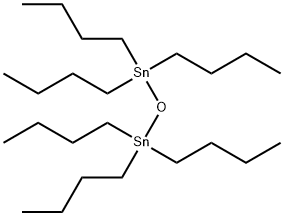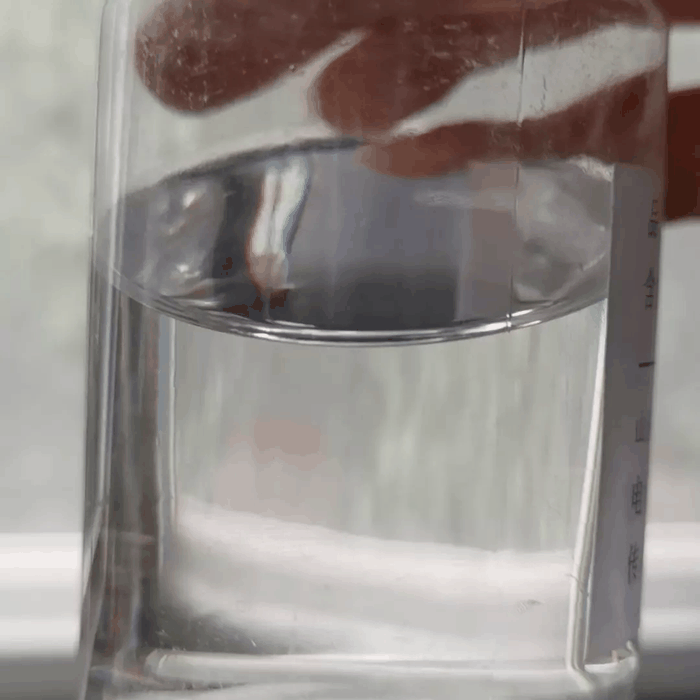Bis(tributyltin) oxide
Synonym(s):Bis[tri-n-butyltin(IV)]oxide;HBD;Hexabutyldistannoxane;TBTO;Tributyltin(IV) oxide
- CAS NO.:56-35-9
- Empirical Formula: C24H54OSn2
- Molecular Weight: 596.1
- MDL number: MFCD00009418
- EINECS: 200-268-0
- SAFETY DATA SHEET (SDS)
- Update Date: 2025-09-25 17:15:13

What is Bis(tributyltin) oxide?
Description
TBTO (bis(tri-n-butyltin)oxide) appears as thin, colourless to pale yellow, flammable and combustible liquid. It is soluble in organic solvents. TBTO, or bis(tri-n-butyltin)oxide, is an organotin compound used as a biocide, fungicide, and molluscicide. Uses of tributyltin also include as an anti-fouling chemical in marine paints for boats, anti-fungal agent in textiles and industrial water systems, in cooling tower and refrigeration water systems, wood pulp preservative in paints and paper mill systems, inner surfaces of cardboard, and in the manufacturing processes of leather goods, textiles, wood, plastics, and mothproof stored garments. In fact, TBT compounds are considered the most hazardous of all tin compounds.
Description
Tributyltin oxide, or, more formally, bis(tri-1-butyltin) oxide, is a rather nasty substance and a potent biocide. Like most volatile organotin compounds, it can cause ill effects ranging from skin irritation to convulsions. Its main use is as a wood preservative. It was formerly used as a marine anti-biofouling agent, but evidence of toxicity to marine animals led to a worldwide ban by the International Maritime Organization. Other pesticide uses of the compound have also been discontinued.
Chemical properties
Clear colorless liquid
The Uses of Bis(tributyltin) oxide
Bis(tributyltin) Oxide is an organotin compound used as a fungicide and molluscicide, particularly in wood preservation. Bis(tributyltin) Oxide was used as an active component in marine antifouling paints but is not longer used due to its toxicity and is considered a severe marine pollutant.
The Uses of Bis(tributyltin) oxide
Bis(tributyltin) oxide is widely used in Europe for the preservation of timber, millwork, and wood joinery, eg, window sashes and door frames. It is applied from organic solution by dipping or vacuum impregnation. It imparts resistance to attack by fungi and insects but is not suitable for underground use. An advantage of bis(tributyltin) oxide is that it does not interfere with subsequent painting or decorative staining and does not change the natural color of the wood.
The Uses of Bis(tributyltin) oxide
Tributyltin oxide is used as an antifouling and biocide agent against fungi, algae and bacteria in paints and is an irritant.
What are the applications of Application
Bis(tributyltin) oxide is an immunosuppressive compound
Definition
ChEBI: Tributyltin oxide is an inorganic molecular entity.
General Description
Clear pale yellow liquid. Toxic by skin absorption or inhalation of vapors. Used as a bactericide, fungicide and chemical intermediate.
Air & Water Reactions
Insoluble in water.
Reactivity Profile
Bis(tributyltin) oxide may react vigorously with oxidizing agents and with reducing agents.
Hazard
Toxic via ingestion and inhalation.
Health Hazard
ACUTE/CHRONIC HAZARDS: Bis(tributyltin) oxide is toxic by ingestion and inhalation and is a skin and eye irritant.
Fire Hazard
Bis(tributyltin) oxide is probably combustible.
Contact allergens
Tributyl tin oxide is used as an antifouling and biocide agent against fungi, algae, and bacteria, particularly in paints. Sometimes used in chemistry, tributyltin oxide is a strong irritant.
Properties of Bis(tributyltin) oxide
| Melting point: | -45°C |
| Boiling point: | 180 °C2 mm Hg(lit.) |
| Density | 1.17 g/mL at 25 °C(lit.) |
| vapor pressure | <0.01 mm Hg ( 25 °C) |
| refractive index | n |
| Flash point: | >230 °F |
| storage temp. | +4°C
|
| solubility | Chloroform (Soluble), Methanol (Slightly) |
| form | liquid |
| color | colorless |
| Specific Gravity | 1.170 |
| Water Solubility | INSOLUBLE |
| Sensitive | Air & Moisture Sensitive |
| Hydrolytic Sensitivity | 5: forms reversible hydrate |
| BRN | 745057 |
| Exposure limits | ACGIH: TWA 0.1 mg/m3; STEL 0.2 mg/m3 (Skin) NIOSH: IDLH 25 mg/m3; TWA 0.1 mg/m3 |
| Stability: | Moisture Sensitive |
| CAS DataBase Reference | 56-35-9(CAS DataBase Reference) |
| NIST Chemistry Reference | Distannoxane, hexabutyl-(56-35-9) |
| EPA Substance Registry System | Bis(tributyltin) oxide (56-35-9) |
Safety information for Bis(tributyltin) oxide
| Signal word | Danger |
| Pictogram(s) |
 Skull and Crossbones Acute Toxicity GHS06  Health Hazard GHS08  Environment GHS09 |
| GHS Hazard Statements |
H301:Acute toxicity,oral H311:Acute toxicity,dermal H315:Skin corrosion/irritation H319:Serious eye damage/eye irritation H360:Reproductive toxicity H372:Specific target organ toxicity, repeated exposure H400:Hazardous to the aquatic environment, acute hazard H410:Hazardous to the aquatic environment, long-term hazard |
| Precautionary Statement Codes |
P260:Do not breathe dust/fume/gas/mist/vapours/spray. P273:Avoid release to the environment. P280:Wear protective gloves/protective clothing/eye protection/face protection. P309:IF exposed or if you feel unwell: P310:Immediately call a POISON CENTER or doctor/physician. P305+P351+P338:IF IN EYES: Rinse cautiously with water for several minutes. Remove contact lenses, if present and easy to do. Continuerinsing. |
Computed Descriptors for Bis(tributyltin) oxide
| InChIKey | APQHKWPGGHMYKJ-UHFFFAOYSA-N |
Bis(tributyltin) oxide manufacturer
New Products
4,4-Difluoropiperidine hydrochloride tert-butyl 9-methoxy-3-azaspiro[5.5]undecane-3-carboxylate Indole Methyl Resin N-Isopropylurea N,N-Dicyclohexylcarbodiimide(DCC) MELDRUMS ACID 5-METHYLISOXAZOLE-4-CARBOXYLIC ACID Magnessium Bis glycinate Zinc ascorbate 1-bromo-2-butyne 2-acetamidophenol 9(10H)-anthracenone Erythrosin B, 4-Piperidinopiperidine 2-((4-morpholinophenylamino) (methylthio) methylene) malononitrile 2,4-dihydroxybenzaldehyde 3-(4-morpholinophenylamino)-5-amino-1H-pyrazole-4-carbonitrile Methyl 2-methylquinoline-6-carboxylate 2,6-dichloro-4-nitropyridine 4-Bromo-2-chlorobenzonitrile 2-(benzylamino)acetic acid hydrochloride 4-(tert-Butoxycarbonylamino)but- 2-ynoic acid 3,4-dihydro-2H-benzo[b][1,4]dioxepine 1-Phenyl-1-cycloprppanecarboxylicacidRelated products of tetrahydrofuran








You may like
-
 56-35-9 99%View Details
56-35-9 99%View Details
56-35-9 -
 56-35-9 99%View Details
56-35-9 99%View Details
56-35-9 -
 Bis(tri-n-butyltin)oxide 97.00% CAS 56-35-9View Details
Bis(tri-n-butyltin)oxide 97.00% CAS 56-35-9View Details
56-35-9 -
 Bis(tributyltin) oxide CAS 56-35-9View Details
Bis(tributyltin) oxide CAS 56-35-9View Details
56-35-9 -
 bis(Tributyltin) oxide, 96% CAS 56-35-9View Details
bis(Tributyltin) oxide, 96% CAS 56-35-9View Details
56-35-9 -
 TRIBUTYLTIN OXIDE For Synthesis CAS 56-35-9View Details
TRIBUTYLTIN OXIDE For Synthesis CAS 56-35-9View Details
56-35-9 -
 20677-73-0 (2,2-diethoxyethyl)methylamine 98%View Details
20677-73-0 (2,2-diethoxyethyl)methylamine 98%View Details
20677-73-0 -
 3-(4-(hydroxyamino)-1-oxoisoindolin-2-yl)piperidine-2,6-dione 98%View Details
3-(4-(hydroxyamino)-1-oxoisoindolin-2-yl)piperidine-2,6-dione 98%View Details
